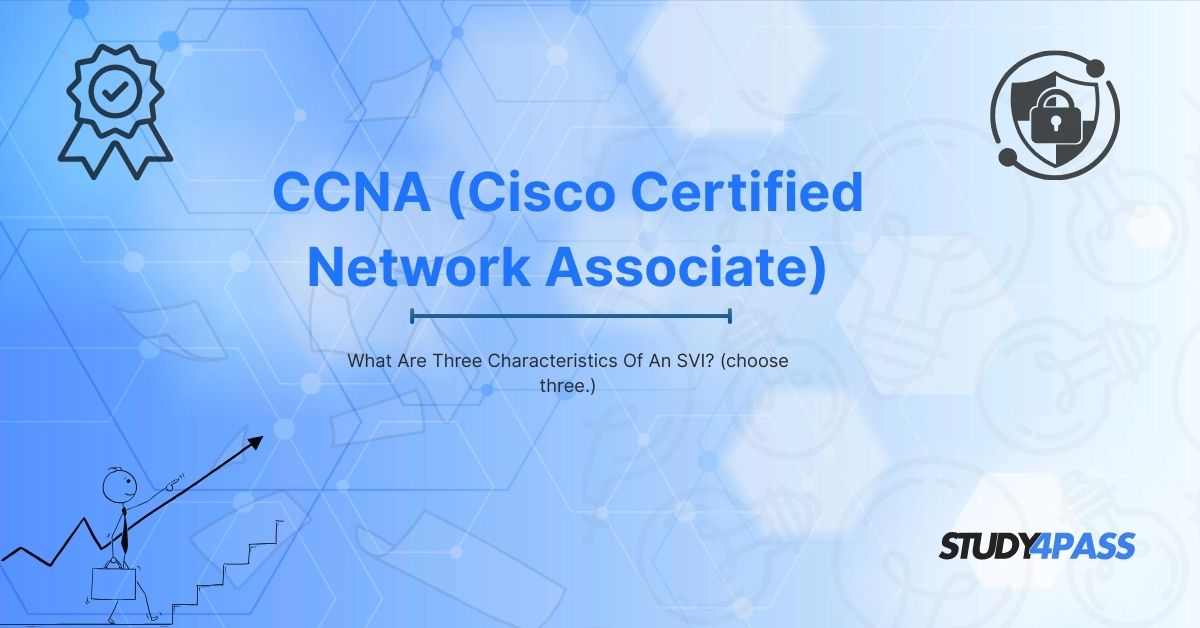Introduction
The Cisco Certified Network Associate (CCNA) certification is one of the most prestigious credentials in the networking industry. As part of the CCNA 1 V7 course, students encounter various networking concepts, including Switched Virtual Interfaces (SVIs). Understanding SVIs is crucial for configuring and managing VLANs (Virtual Local Area Networks) in Cisco devices.
In this article, we will explore three key characteristics of an SVI as per the CCNA 1 V7 Checkpoint Exam. Additionally, we will discuss how Study4Pass can help you prepare effectively for your CCNA certification.
What Is an SVI (Switched Virtual Interface)?
An SVI (Switched Virtual Interface) is a virtual interface configured on a Layer 3 switch to facilitate inter-VLAN routing. Unlike physical interfaces, SVIs are logical and are associated with VLANs. They allow a multilayer switch to route traffic between VLANs without needing an external router.
Key Functions of an SVI:
- Enables inter-VLAN communication.
- Provides a management interface for VLANs.
- Acts as a default gateway for devices within a VLAN.
Now, let’s dive into the three primary characteristics of an SVI as outlined in the CCNA 1 V7 Checkpoint Exam.
Three Characteristics of an SVI
1. An SVI Is a Virtual Interface Associated with a VLAN
One of the most fundamental characteristics of an SVI is that it is a logical (virtual) interface rather than a physical one. Each SVI corresponds to a specific VLAN configured on the switch.
- How It Works:
- When a VLAN is created (e.g., VLAN 10), an SVI can be configured for that VLAN (e.g., interface vlan 10).
- The SVI provides Layer 3 routing capabilities for devices within that VLAN.
- Why It Matters:
- Eliminates the need for a physical router for inter-VLAN communication.
- Simplifies network management by allowing a single switch to handle both switching and routing.
2. An SVI Provides a Management Interface for a Switch
Another critical characteristic of an SVI is its role in switch management.
- How It Works:
- By assigning an IP address to an SVI (e.g., VLAN 1), administrators can remotely access the switch via SSH, Telnet, or HTTP/HTTPS.
- Example Configuration:
interface vlan 1
ip address 192.168.1.1 255.255.255.0
no shutdown
- Why It Matters:
- Ensures secure and efficient remote management.
- Reduces dependency on physical console access.
An SVI Is Required for Inter-VLAN Routing
The third key characteristic of an SVI is its role in inter-VLAN routing.
- How It Works:
- Without an SVI, devices in different VLANs cannot communicate because VLANs operate at Layer 2 (Data Link Layer).
- An SVI acts as a Layer 3 (Network Layer) gateway, allowing traffic to pass between VLANs.
- Why It Matters:
- Enhances network segmentation and security.
- Improves performance by reducing reliance on external routers.
How Study4Pass Helps You Master CCNA Concepts Like SVIs?
Preparing for the CCNA 1 V7 Checkpoint Exam requires a deep understanding of networking concepts, including SVIs, VLANs, and inter-VLAN routing. Study4Pass is an excellent resource for CCNA candidates, offering:
Comprehensive Study Guides – Detailed explanations of CCNA topics, including SVIs.
Practice Exams – Simulated test questions to help you assess your knowledge.
Hands-On Labs – Virtual lab environments to practice SVI configurations.
Expert Support – Access to networking professionals for doubt resolution.
By leveraging Study4Pass, you can gain the confidence and skills needed to ace your CCNA exam and excel in real-world networking scenarios.
Conclusion
Understanding Switched Virtual Interfaces (SVIs) is essential for any aspiring network engineer. The three key characteristics of an SVI are:
- It is a virtual interface associated with a VLAN.
- It provides a management interface for a switch.
- It is required for inter-VLAN routing.
Mastering these concepts is crucial for passing the CCNA 1 V7 Checkpoint Exam and advancing your networking career. For the best preparation, consider using Study4Pass, a trusted platform for CCNA exam success.
Start your journey today and achieve your Cisco Certified Network Associate (CCNA) certification with confidence!
Final Words
If you found this article helpful, explore Study4Pass for more CCNA study materials, practice tests, and expert guidance. Your success in networking starts here!
Special Discount: Offer Valid For Limited Time “200-301 Exam Prep Practice Tests PDF”
Sample Questions for Cisco 200-301 Exam Prep Practice Test
Actual exam questions from Cisco's 200-301 Exam
1. Which of the following are characteristics of an SVI? (Choose three.)
a) It is a virtual interface associated with a VLAN.
b) It provides Layer 3 routing for VLANs.
c) It is a physical interface on a switch.
d) It requires an IP address for inter-VLAN routing.
e) It is only used for Layer 2 switching.
2. What is the primary purpose of an SVI?
a) To connect physical devices directly to a switch.
b) To enable Layer 3 routing for a VLAN.
c) To increase the number of available physical ports.
d) To replace trunk ports in a network.
3. Which statement about an SVI is true?
a) An SVI is always in an "up/up" state.
b) An SVI is created automatically for all VLANs.
c) An SVI must be manually configured for a VLAN to enable routing.
d) An SVI does not require an IP address.
4. How does an SVI facilitate inter-VLAN communication?
a) By acting as a default gateway for devices in a VLAN.
b) By extending broadcast domains across multiple switches.
c) By converting Layer 2 switches into Layer 1 hubs.
d) By disabling MAC address learning.
5. Which of the following is NOT a characteristic of an SVI?
a) It is associated with a VLAN.
b) It operates at Layer 3 of the OSI model.
c) It is a physical interface.
d) It can be assigned an IP address.


